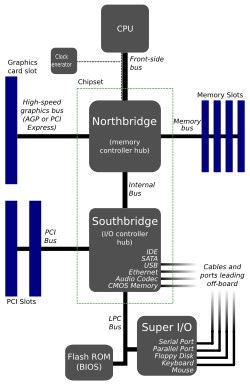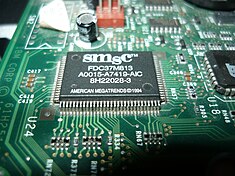


Super I/O (sometimes Multi-IO) is a class of I/O controller integrated circuits that began to be used on personal computer motherboards in the late 1980s, originally as add-in cards, later embedded on the motherboards. A super I/O chip combines interfaces for a variety of low-bandwidth devices. Now it is mostly merged with EC.
Functions
The functions below are usually provided by the super I/O if they are on the motherboard:
- A floppy-disk controller
- An IEEE 1284-compatible parallel port (commonly used for printers)
- One or more 16C550-compatible serial port UARTs
- Keyboard controller for PS/2 keyboard and/or mouse
Most Super I/O chips include some additional low-speed devices, such as:
- Temperature, voltage, and fan speed interface
- Connect temperature and voltage sensors via SMBus
- Thermal Zone
- Chassis intrusion detection
- Mainboard power management, including control voltage regulator module
- LED management
- PWM fan speed control
- An IrDA Port controller
- A game port (not provided by recent super I/O chips because Windows XP is the last Windows OS to natively support game ports, requiring vendors to supply their own drivers for later Windows operating systems)
- A watchdog timer
- A consumer IR receiver
- A MIDI port
- Some GPIO pins
- Legacy Plug and Play or ACPI support for the included devices
By combining many functions in a single chip, the number of parts needed on a motherboard is reduced, thus reducing the cost of production.
History
The original super I/O chips communicated with the central processing unit (CPU) via the ISA bus. With the evolution away from ISA towards use of the PCI bus, the Super I/O chip was often the biggest remaining reason for continuing inclusion of ISA on the motherboard.
Later super I/O chips use the LPC bus instead of ISA for communication with the central processing unit. This normally occurs through an LPC interface on the Southbridge chip of the motherboard.
Since Intel is replacing the LPC bus with the eSPI bus, super I/O chips that connect to that bus have appeared on the market.
Companies that make super I/O controllers include Nuvoton (spun off from Winbond), ITE Inc. [zh], Fintek Inc. ,ENE Tech. (for laptop) and Microchip Technology (which bought SMSC™). National Semiconductor used to make super I/O controllers but sold that business to Winbond at 2005, which already had a competing super I/O controller business. In 2008, Winbond then spun off its logic businesses to a wholly owned subsidiary, Nuvoton. SMSC made super I/O chips and then got acquired by Microchip Technology.
Common models
This is a dynamic list and may never be able to satisfy particular standards for completeness. You can help by adding missing items with reliable sources.ENE Tech.
Many models are used for laptops with built-in keyboard controllers
- KB3930
- KB930QF
ITE Inc.
- T8510E series
Microchip Technology (SMSC)
Microchip Technology provides Super I/O components with their SCH, MEC and LPC47 series. Here are some examples:
- SCH3112
- SCH3114
- SCH3116
- SCH3223
Nuvoton Technology (Winbond)
- NCT6776
See also
- envsys
- hw.sensors
- lm_sensors contains a tool named sensors-detect that can also detect which Super I/O is used on a mainboard
- SpeedFan
- Embedded controller (EC)
References
- Leonhardt, Frank (1995). Personal Computer World. VNU Business Publications. p. 347.
- ^ "Super I/O Chip Examples". Archived from the original on 2008-05-18.
- Constantine A. Murenin (2007-04-17). Generalised Interfacing with Microprocessor System Hardware Monitors. Proceedings of 2007 IEEE International Conference on Networking, Sensing and Control, 15–17 April 2007. London, United Kingdom: IEEE. doi:10.1109/ICNSC.2007.372901. ISBN 978-1-4244-1076-7. IEEE ICNSC 2007, pp. 901—906.
- ^ Julien Bordet (2003). "it — ITE IT8705F/12F/16F and SiS SiS950 Super I/O Hardware Monitor". BSD Cross Reference. DragonFly BSD. Retrieved 2019-03-07.
- "it -- ITE IT8705F/12F/16F and SiS SiS950 Super I/O Hardware Monitor". DragonFly On-Line Manual Pages.
- Constantine A. Murenin (2010-05-21). OpenBSD Hardware Sensors — Environmental Monitoring and Fan Control (MMath thesis). University of Waterloo: UWSpace. hdl:10012/5234. Document ID: ab71498b6b1a60ff817b29d56997a418.
- Budruk, Ravi; Anderson, Don; Shanley, Tom (2004). PCI Express System Architecture. Addison-Wesley. p. 16. ISBN 978-0-321-15630-3.
- Alexander Yurchenko (2005). "fins — Fintek F71805F LPC Super I/O". BSD Cross Reference. OpenBSD. Retrieved 2019-03-07.
- "fins — Fintek F71805F LPC Super I/O". OpenBSD manual page server.
External links
- Superiotool is a Linux user-space tool to detect which Super I/O is used on a mainboard, and it can provide detailed information about its register contents.